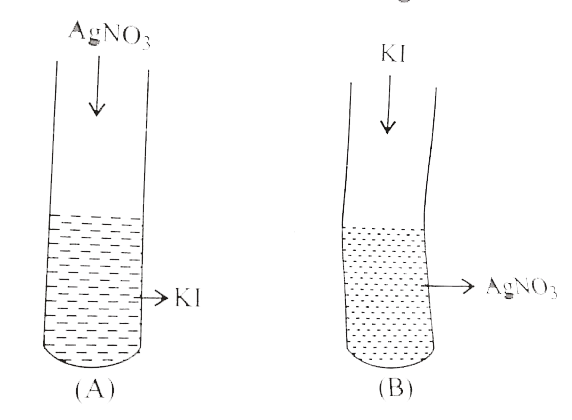What is type of charge on Agl colloidal sol formed when AgNO3 is added to Kl solution ?
Negatively charged sol AgI/I− is formed when AgNO3 solution is added to KI solution.
Topper's Solved these Questions
- SURFACE CHEMISTRYBOOK - U-LIKE SERIESCHAPTER - SURFACE CHEMISTRYEXERCISE - SHORT ANSWER QUESTIONS
39 Videos
- SURFACE CHEMISTRYBOOK - U-LIKE SERIESCHAPTER - SURFACE CHEMISTRYEXERCISE - LONG ANSWER QUESTIONS-I
76 Videos
- SURFACE CHEMISTRYBOOK - U-LIKE SERIESCHAPTER - SURFACE CHEMISTRYEXERCISE - FILL IN THE BLANKS
8 Videos
- SOLUTIONBOOK - U-LIKE SERIESCHAPTER - SOLUTIONEXERCISE - SELF ASSESSMENT TEST (SECTION D)
2 Videos
- THE D-AND F-BLOCK ELEMENTS BOOK - U-LIKE SERIESCHAPTER - THE D-AND F-BLOCK ELEMENTS EXERCISE - SELF ASSESSMENT TEST (SECTION A ) MULTIPLE CHOICE QUESTIONS (CHOOSE THE CORRECT OPTION)
7 Videos
Similar Questions
Type of collcidal solutions result when AgNO3
Solution is added to Kl solution and when Kl solution
is added so AgNO3 soultion are respectively
View SolutionWhat will be the charge on Agl colloidal particles when it is prepared by adding small amount of AgNO3 solution to KI solution in water? What is responsible for the development of this charge?
View Solution
Knowledge Check
Type of collcidal solutions result when AgNO3
Solution is added to Kl solution and when Kl solution
is added so AgNO3 soultion are respectivelyANegatively and postitvely chargedBBoth negatively chargedCPositively and negatively chargedDBoth positively chargedAssertion (A) : AgI/I− is a negatively charged sol.
Reason (R) : When a dilute solution of AgNO3 is added to a dilute solution of KI, the precipitated Agl absorbs I− ions from dispersion medium.ABoth Assertion (A) and Reason (R) are correct statements, and Reason (R) is the correct explanation of the Assertion (A).BBoth Assertion (A) and Reason (R) are correct statements, but Reason (R) is not the correct explanation of the Assertion (A)CAssertion (A) is correct, but Reason (R) is incorrect statement.DAssertion (A) is incorrect, but Reason (R) is correct statement
When AgNO3 is added in KI, Which sol is formed
View SolutionRead the given passage and answer the questions number 1 to 5 that follow :
Colloidal particles always carry an electric charge which may be either positive or negative. For example, when AgNO3 solution is added to Kl solution, a negatively charged colloidal sol is obtained. The presence of equal and similar charges on colloidal particles provide stability to the colloidal sol and if, somehow, charge is removed, coagulation of sol occurs. Lyophobic sols are readily coagulated as compare to lyophilic sols.
Why a negatively charged sol is obtained on adding AgNO3 solution to KI solution ?
View SolutionWhat type of colloidal sols are formed in the following?
Soap solution
View SolutionRead the given passage and answer the question that follow:
Colloidal particles always carry an electric charge which may be either positive or negative. For example, when AgNO3 solution is added to KI solution, a negatively charged colloidal sol is obtained. The presence of equal and similar charges on colloidal particles provide stability to the colloidal sol and if, somehow, charge is removed. coagulation of sol occurs. Lyophobic sols are readily coagulated as compared to lyophilic sols.
Why a negatively charged sol is obtained on adding AgNO3 solution to Kl solution?
View SolutionRead the given passage and answer the question that follow:
Colloidal particles always carry an electric charge which may be either positive or negative. For example, when AgNO3 solution is added to KI solution, a negatively charged colloidal sol is obtained. The presence of equal and similar charges on colloidal particles provide stability to the colloidal sol and if, somehow, charge is removed. coagulation of sol occurs. Lyophobic sols are readily coagulated as compared to lyophilic sols.
Why a negatively charged sol is obtained on adding AgNO3 solution to Kl solution?
View SolutionA colloidal solution of Agl is prepared by two different methods as shown in the figure below:


What is the charge of Agl colloidal particles in the two test tubes (A) and (B) ?
b. Given reasons for the origin of charge.
View Solution
